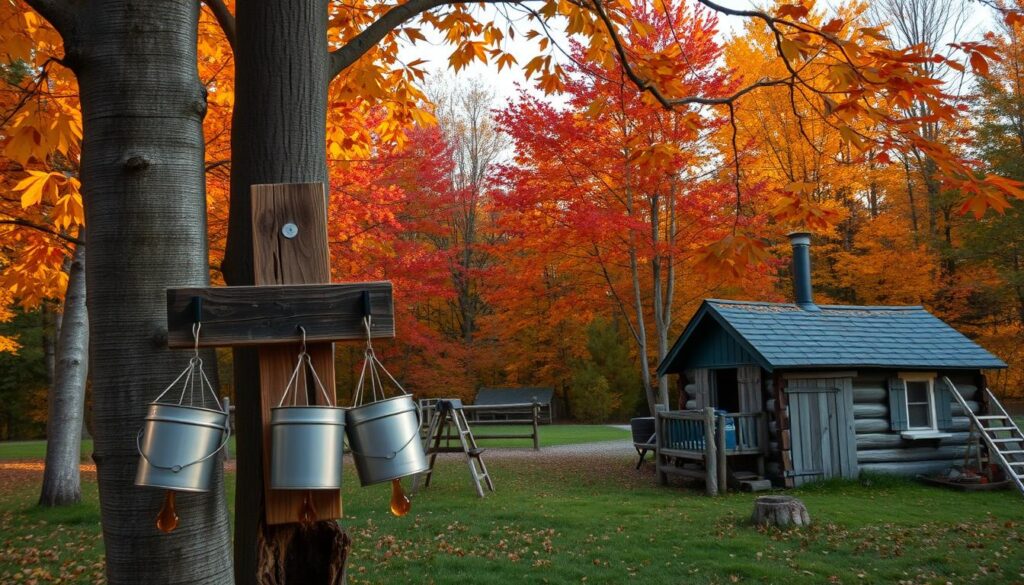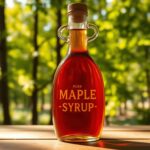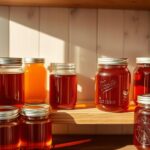Discover the liquid gold of the Empire State. New York maple syrup is a culinary treasure. It turns simple moments into unforgettable experiences. Skilled sugarmakers have passed down their craft for generations.
Your journey into authentic maple syrup starts in New York’s lush forests. Premium maple syrup production thrives here. Each drop has a story, extracted from mature maple trees that have seen many seasons.
New York maple syrup is different from mass-produced syrups. Their focus on quality turns simple sap into a complex, nuanced delicacy. The state’s unique climate and maple tree varieties give it a flavor that’s hard to find elsewhere.
Passionate sugarmakers tap trees in late winter and early spring. They watch temperatures and sap flow closely. Making authentic maple syrup takes patience, skill, and respect for nature.
From small family farms to big producers, New York maple syrup is more than a sweetener. It connects us to the land, tradition, and sustainable farming that have shaped the region for years.
The Rich Heritage of New York Maple Syrup Production
New York maple syrup has a deep history that goes back centuries. It combines Indigenous traditions and colonial innovations. The story of maple syrup in New York shows the strength of culture and skill in farming.
Indigenous Roots of Maple Harvesting
Native American tribes were the first to make maple syrup. They had smart ways to get sap long before Europeans came. Their methods included:
- Making V-shaped cuts in maple tree bark
- Using hollowed-out wooden tubes to direct sap flow
- Boiling sap using heated stones
Colonial Development and Transformation
European settlers soon learned from Native Americans. They brought metal tools and big iron kettles. This changed how syrup was made. Maple syrup became key for early New York communities.
Evolution of Syrup Making Techniques
New York maple syrup production has changed a lot. It shows how technology and culture mix. Important changes include:
- Introduction of metal spouts in the early 19th century
- Development of evaporation pans
- Mechanical sap collection systems
Modern Day Traditional Methods
Today, New York maple syrup makers use old ways and new tech. Small-batch producers keep the tradition alive. They also use new methods to make syrup better and more efficient.
Understanding Pure Maple Syrup Grades and Classifications
Natural maple syrup is a special treat with a detailed grading system. This system shows the syrup’s different flavors, colors, and strengths. It helps us understand the unique qualities of pure maple syrup.
The maple syrup industry has a clear grading system. It has four main categories, each with its own taste:
- Golden Color, Delicate Taste: The lightest grade, perfect for those who appreciate subtle maple flavors
- Amber Color, Rich Taste: A medium-intensity syrup ideal for everyday use
- Dark Color, Robust Taste: Strong maple flavor excellent for cooking
- Very Dark Color, Strong Taste: The most intense maple experience
Sugarmakers carefully make these grades by watching the maple sap collection process all season. The syrup’s taste changes because of:
- When sap is collected
- Tree health
- How it’s processed
- Environmental conditions
Choosing the right maple syrup grade depends on what you like and how you use it. Lighter syrups are great for baking and drizzling. Darker syrups are better for marinades and strong dishes.
The Maple Tree Varieties of the Empire State
New York maple syrup is top-notch thanks to the many maple tree types across the state. The Empire State’s landscape is perfect for these trees. Each tree adds its own special touch to this sweet treasure.
The maple forest in New York is a complex network of trees. These trees are key to making syrup. Knowing about these trees helps syrup makers get the most from their harvests.
Sugar Maple: The Premium Source
The sugar maple is the star of syrup making. It has high sugar content and great sap quality. This makes it the top choice for New York’s maple forests.
Sugarmakers love sugar maples for their:
- Superior sap sugar concentration
- Robust and rich syrup flavor profile
- Optimal sap yield during harvesting seasons
Black and Red Maple Contributions
Black and red maple trees also play big roles in syrup making. They add special qualities that make the syrup even better.
| Maple Tree Variety | Sap Sugar Content | Flavor Profile |
|---|---|---|
| Sugar Maple | 2-3% | Rich, Classic |
| Black Maple | 1.5-2.5% | Smooth, Mild |
| Red Maple | 1-2% | Light, Delicate |
Optimal Growing Conditions
New York’s varied landscape is perfect for maple trees. Soil, elevation, and climate all help make great syrup. The Adirondack and Catskill regions are the best places for these trees.
The connection between maple trees and their environment makes each syrup drop special. It tells a story of New York’s rich farming history.
Seasonal Harvesting: When Nature Dictates Production
Producing authentic maple syrup is a dance with nature. Temperature and timing are key. In New York’s maple forests, sugarmakers wait for the right moment.
The maple syrup harvest lasts 4-6 weeks, from February to April. This time depends on weather that makes sap flow in maple trees. The best harvesting happens when:
- Daytime temperatures are above 40°F (4°C)
- Nighttime temperatures are below freezing (32°F or 0°C)
- Temperatures keep changing
Climate changes affect traditional harvesting. Producers are changing their ways to keep their syrup quality high. These changes can make the harvest season shorter or longer.
Sugarmakers use old knowledge and new tools to get the most from their trees. They tap maple trees carefully. Each tree’s sap flow is different, based on the forest’s microclimate.
“Every drop of maple sap tells a story of patience, precision, and respect for nature’s rhythms.” – New York Maple Producers Association
Maple syrup production is special because of its seasonal nature. It’s different from mass-produced sweeteners. Each batch of authentic maple syrup shows its natural roots.
Artisanal Production Methods in New York State
New York’s maple syrup production is a mix of old traditions and new methods. This shows the state’s dedication to quality and realness.
Handcrafted maple syrup starts in New York’s dense forests. Making small batches needs careful work, patience, and knowing maple trees well.
Traditional Tapping Techniques
Producers use methods that have been passed down for years. The tapping process includes:
- Picking the right maple trees
- Drilling tap holes carefully
- Putting in collection spouts gently
- Watching sap flow during the best times
Modern Sustainable Practices
Today’s maple syrup makers also use green methods to protect forests. These include:
- Less harm to trees during tapping
- Using energy-saving boiling tools
- Good forest management
- Keeping maple forests diverse
Small Batch Processing
The small batch method helps keep quality high. Each batch gets special care, making sure it tastes unique.
New York’s maple syrup makers focus on quality and caring for the environment. They make a product that’s both delicious and eco-friendly.
Why New York Maple Syrup Stands Apart
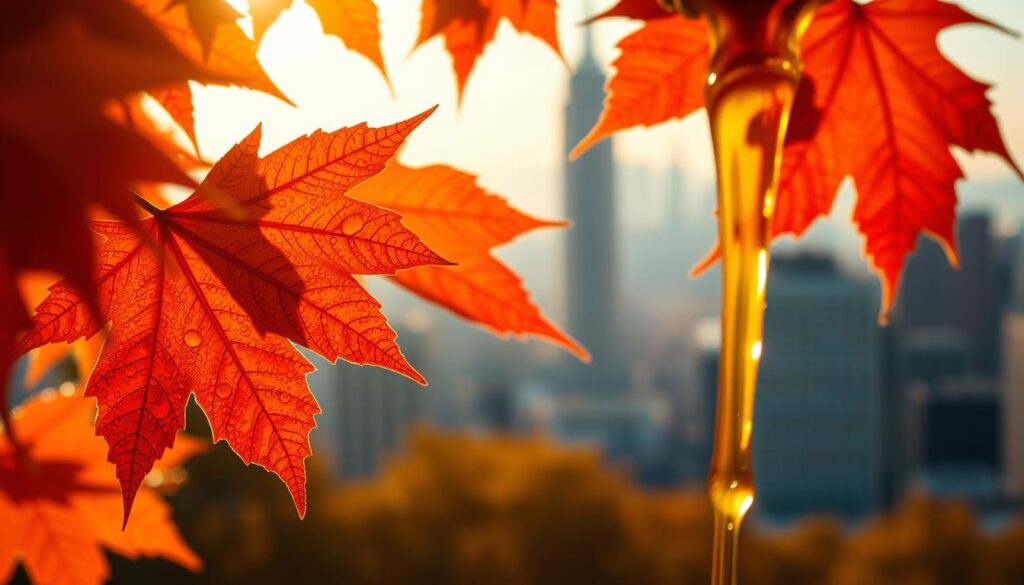
New York maple syrup is a top choice for its quality and unique taste. The state’s special terroir gives it a flavor that’s different from other maple syrups in North America.
Several factors make New York maple syrup stand out:
- Precise microclimate conditions in the Adirondack and Catskill regions
- Stringent production standards that ensure superior quality
- Generational expertise passed down through local sugarmakers
Sugarmakers in New York are very proud of their work. They use old methods and new, green ways. The unique production methods make the syrup’s taste special.
| Characteristic | New York Maple Syrup Advantage |
|---|---|
| Flavor Complexity | Rich, nuanced taste reflecting regional forest ecosystems |
| Production Standards | Strict quality control and artisanal processing |
| Environmental Impact | Sustainable harvesting practices that protect forest health |
The state works hard to keep maple syrup traditions alive. Each bottle of syrup is a true taste of New York’s nature. From picking the right trees to boiling the sap, every step shows respect for the land.
Maple syrup lovers see New York’s syrup as a top choice. It shows the skill of northeastern woodcraft. The perfect mix of great growing spots, expert skills, and love for quality makes New York maple syrup truly special.
Natural Benefits and Nutritional Value of Pure Maple Syrup
Natural maple syrup is more than just a tasty sweetener. It’s a nutritional powerhouse with essential minerals and health-boosting compounds. Unlike refined sugars, pure maple syrup is a better choice for those who care about their health.
For those looking for a natural sweetener, pure maple syrup is a top pick. It has a great mix of minerals and antioxidants. This makes it stand out from artificial sweeteners.
Essential Minerals and Antioxidants
Pure maple syrup is full of nutrients that are good for your health. It has important minerals like:
- Manganese: Helps with bone health and metabolism
- Zinc: Boosts your immune system
- Calcium: Makes bones and teeth strong
- Potassium: Keeps your heart and muscles working right
“Maple syrup is nature’s multivitamin, delivering essential nutrients in a delicious package.” – Nutrition Experts
Comparing Natural vs Artificial Sweeteners
Pure maple syrup is different from artificial sweeteners in many ways. While artificial sweeteners have no calories, they don’t have the nutrients of maple syrup. Maple syrup has minerals and antioxidants that help your body work well.
| Sweetener Type | Mineral Content | Antioxidant Levels |
|---|---|---|
| Pure Maple Syrup | High | Significant |
| Artificial Sweeteners | None | Minimal |
Choosing pure maple syrup means picking a natural sweetener that tastes great and helps you meet your nutritional goals.
Supporting Local New York Maple Producers
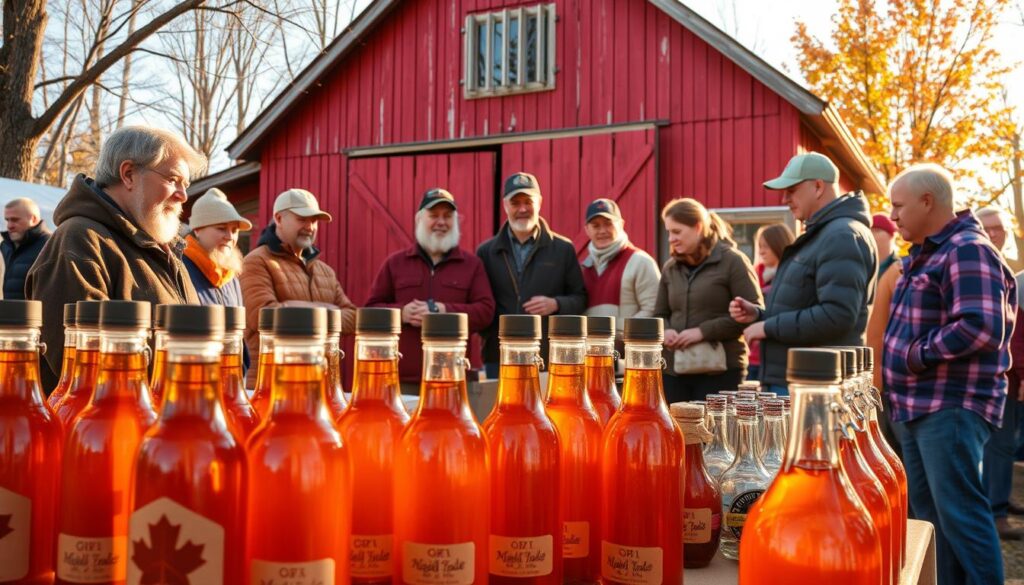
Choosing local maple syrup is more than just a food choice. It’s a way to support New York’s farming history. Local maple syrup makers are key to the state’s economy and culture. They keep old traditions alive and offer top-notch syrup.
Buying local maple syrup has many advantages:
- It helps local economies grow
- It cuts down on carbon emissions by using less fuel
- It means you get syrup that’s fresh and of high quality
- It helps keep farming traditions alive
There are many ways to find local maple syrup:
- Farmers’ markets
- Direct farm stands
- Community-supported agriculture programs
- Local cooperative networks
| Purchasing Channel | Benefits | Availability |
|---|---|---|
| Farmers’ Markets | Direct interaction with producers | Seasonal |
| Farm Stands | Freshest local maple syrup | Year-round |
| CSA Programs | Regular supply and community support | Subscription-based |
By choosing local maple syrup, you help keep New York’s maple syrup tradition alive. You also support small farmers and their families.
Organic Certification and Sustainable Practices
New York’s maple syrup makers are dedicated to keeping nature safe while making top-notch organic maple syrup. They follow strict rules to get certified organic. These rules help protect the environment and keep the syrup quality high.
At the heart of organic maple syrup making is caring for the forest. Producers use methods that keep the forest healthy and full of life.
Environmental Stewardship in Maple Syrup Production
Organic maple syrup making does more than just tap trees. It also protects the forest’s delicate balance. Here’s how:
- They tap trees carefully to avoid damage.
- They keep the forest diverse.
- They safeguard animal homes.
- They cut down on soil and water pollution.
Certification Requirements
To get organic certification for maple syrup, producers must meet USDA rules. These rules are strict to ensure the syrup is pure.
| Certification Criteria | Requirements |
|---|---|
| Forest Management | No synthetic pesticides or chemicals |
| Tapping Practices | Minimal tree impact, sustainable harvesting |
| Documentation | Detailed traceability of sap collection |
| Inspections | Regular independent forest assessments |
Organic maple syrup is more than a product. It’s a promise to care for the environment and deliver quality.
Culinary Applications Beyond Breakfast
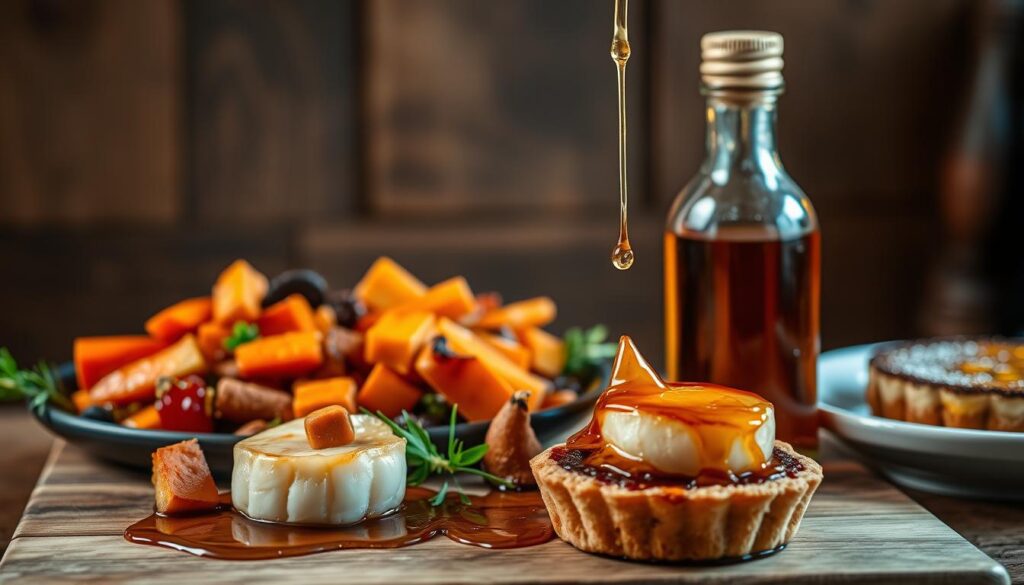
Pure maple syrup is more than just for breakfast. It’s a versatile ingredient that makes both sweet and savory dishes better. Chefs and home cooks are finding that it adds rich, complex flavors to many recipes.
Creative cooks are using pure maple syrup in many ways:
- Marinades for grilled meats
- Glazes for roasted vegetables
- Unique salad dressing bases
- Craft cocktail sweeteners
- Innovative baking ingredients
Different maple syrup grades bring unique flavors to dishes. Dark amber artisanal maple syrup is great for hearty meat dishes. Lighter grades are perfect for delicate desserts and baked goods.
Professional kitchens are using maple syrup in new ways. It’s a sophisticated sweetener for savory sauces and pastry glazes. This natural ingredient adds a special flavor that makes dishes stand out.
“Maple syrup is not just a condiment, it’s a culinary canvas waiting to be explored.” – New York Maple Producers Association
Home cooks can explore maple syrup’s versatility. Try drizzling it over roasted squash or making a complex reduction for a fancy dish. Artisanal maple syrup opens up endless possibilities in the kitchen.
Storage Tips for Preserving Your Artisanal Maple Syrup
Keeping your pure maple syrup fresh is key. The right storage keeps it tasty for months. It’s a treat you’ll enjoy for a long time.
Ideal Storage Environment
Temperature is very important for your syrup. Keep it between 32°F and 40°F to avoid spoilage. This range keeps its unique flavor.
Unopened syrup can stay at room temperature. But once you open it, refrigeration is a.
Container Selection and Best Practices
- Choose glass containers that are non-reactive and BPA-free
- Select narrow-necked containers with tight-sealing lids
- Opt for 8-16 ounce sizes for convenient storage
- Ensure containers are thoroughly cleaned before use
Shelf Life Management
Artisanal maple syrup lasts a long time if stored right. In the fridge, it can last up to a year. Freezing it at 0°F can extend its life to two or three years. Pro tip: When freezing, use airtight containers to accommodate natural expansion.
Spoilage Prevention
Regular checks are vital for syrup quality. Look out for:
- Visible mold growth
- Cloudy or crystallized appearance
- Unusual color changes
- Thick or abnormal texture
“Proper storage is the key to preserving the authentic flavor of pure maple syrup.” – New York Maple Producers Association
By sticking to these storage tips, your premium maple syrup will stay a culinary gem. It will add a special touch to your dishes with its natural sweetness.
The Economic Impact of New York’s Maple Industry
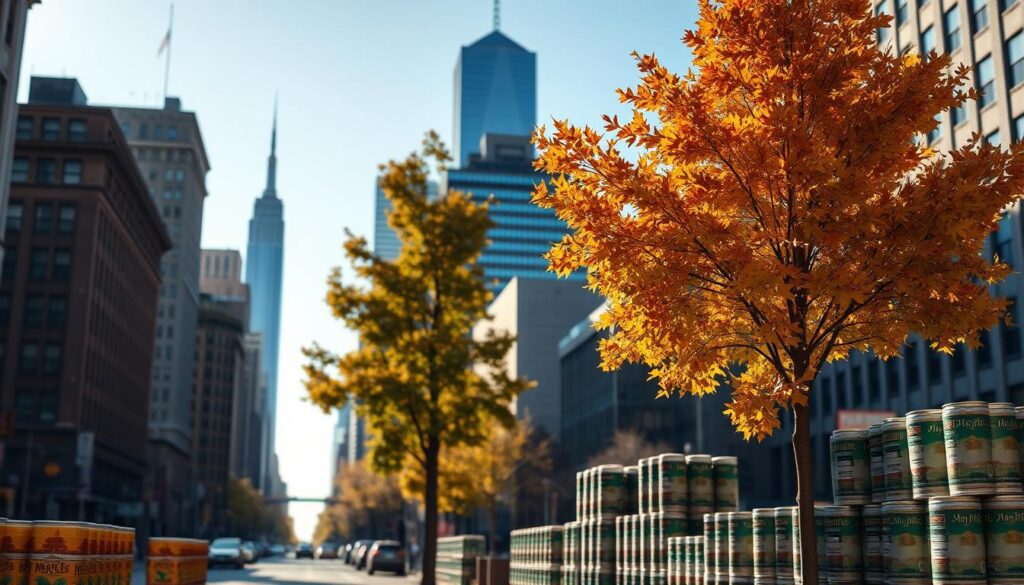
The local maple syrup industry in New York is a big deal. It’s not just about making sweetener. It boosts rural economies and helps many family-owned businesses.
Here are some key economic stats:
- Annual production exceeds 820,000 gallons of maple syrup
- Generates approximately $40 million in direct economic revenue
- Supports over 2,000 local agricultural jobs
Small-scale producers are key in the maple syrup world. They turn old practices into new economic chances. They use agritourism and sell directly to people, helping rural areas.
New York maple syrup’s impact goes beyond just selling syrup. Rural areas get benefits like:
- Tourism spots at maple farms
- Seasonal jobs
- Investments in farm equipment and supplies
State and local governments see the maple industry’s value. They support it with policies and grants. This helps the industry grow and innovate.
Visiting New York Maple Farms: Agritourism Experience
Exploring local maple syrup farms is a journey into New York’s agricultural heart. Visitors dive into the maple syrup tradition through agritourism. It brings the craft to life.
The Maple Weekend is a great chance for food lovers and curious travelers. They can see how local maple syrup is made. Farms in New York State open their doors, sharing the craft’s secrets.
- Interactive farm tours showing maple syrup making
- Live demos of traditional tapping methods
- Tasting fresh New York maple syrup
- Learning about sustainable farming
Visitors get a full experience, not just food tourism. Maple farms become classrooms. Guests learn syrup making from local experts.
| Experience Type | Duration | Learning Opportunity |
|---|---|---|
| Guided Farm Tour | 60-90 minutes | Complete maple production process |
| Tasting Session | 30 minutes | Syrup grade variations |
| Hands-on Workshop | 2 hours | Traditional maple syrup techniques |
New York maple syrup farms are more than just a product. They connect us to agricultural traditions. By joining these experiences, visitors support local farmers. They also learn to appreciate the skill in every maple syrup drop.
How to Choose the Best Small Batch Maple Syrup
Finding the perfect small batch maple syrup takes a keen eye and knowledge of quality signs. Handcrafted maple syrup is more than a sweetener; it’s a taste of the artisan’s passion and the maple tree’s natural goodness.
Looking for top-notch small batch maple syrup means knowing what makes premium syrup stand out. Those who want real flavor should look at a few important things when picking.
Quality Indicators to Evaluate
- Color intensity and transparency
- Flavor complexity and depth
- Consistency and viscosity
- Aroma characteristics
- Organic certification status
Packaging Considerations
The way maple syrup is packaged can tell you a lot about its quality and how it’s made. Glass containers usually keep the syrup’s true taste better than plastic.
- Look for clear glass bottles that showcase the syrup’s natural color
- Check for detailed labeling indicating production region
- Verify seal integrity and packaging date
- Assess producer’s reputation and local sourcing
Knowing these key points helps maple syrup lovers pick the best small batch syrup. This way, they get the real taste of New York’s maple tradition.
Conclusion
New York’s maple syrup journey shows a mix of tradition, skill, and natural beauty. It’s more than a sweetener; it’s a link to the land and its hardworking farmers. The making of pure maple syrup turns simple sap into a rich, healthy treat.
New York maple syrup shows the value of farming and local food. Buying from small producers means better taste and helps keep New York’s food and culture alive. Its unique taste and making process make it stand out from others.
Food lovers and those who care about what they eat look to New York for maple syrup. The industry mixes old ways with new, showing respect for history and skill in farming. Trying these products is like tasting New York’s natural gifts.
The tale of New York maple syrup keeps growing, inviting us to see its journey. It’s a symbol of pride and skill, enjoyed on pancakes, in cooking, or on its own.

